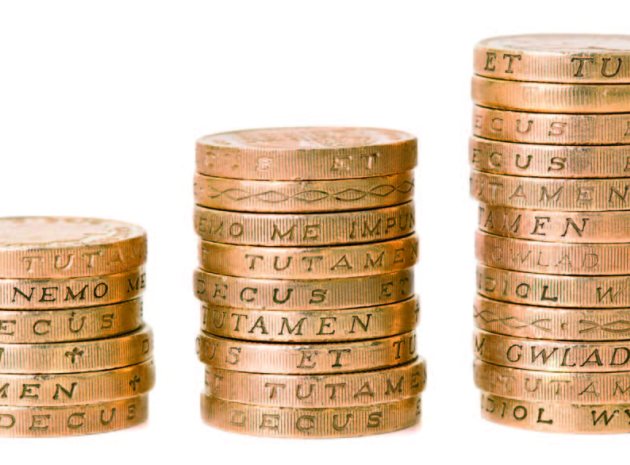Colin Foster believes that money can provide a powerful opportunity for estimation problems in which learners can gain a sense of scale
Colin Foster believes that money can provide a powerful opportunity for estimation problems in which learners can gain a sense of scale
A million pounds sounds like a lot of cash, but exactly how much is it really? Converting a vague notion of ‘wealth’ or ‘riches’ into actual pound coins can be an extremely useful and engaging way of encouraging learners to carry out estimations involving large numbers, mass and volume, as this lesson demonstrates…
TODAY YOU WILL…
Do some estimating with big numbers
STARTER ACTIVITY
Has anyone ever seen or met a millionaire? If you had a million pounds, what would you do with it?
Once learners have got into the context a little, you could ask:
How big is a million?
A million has six zeroes: 1 000 000.
Can you imagine a million pounds?
Suppose I gave you a million pounds – in pound coins, of course! Would it fit in your bag? How many trips home would you have to make to take it all away? What if you had a lorry? Could you get it into one van? Would it even fit in this classroom?
Encourage learners to give their gut reactions. They could do this orally or perhaps on mini-whiteboards. It doesn’t matter if what they say is wrong
– don’t try to correct them at this stage. In this lesson we are going to try to do some calculations to answer these sorts of questions.
MAIN ACTIVITIES
What information do you think we need if we are going to answer these sorts of questions? How do you think we could we get it?
If learners have access to the internet, they could hunt for relevant information themselves.
Alternatively, provide them with the details below. They must select what is important to answer the question that they have chosen. They could work in groups on their solutions.
The United Kingdom £1 Coin
Issued Diameter 21 April 1983 22.5mm
Mass Thickness 9.5 g 3.15mm
Composition Nickel-Brass (70% copper,5.5% nickel, 24.5% zinc)
(source: royalmint.com/en/dis cover/uk-coins/coin-design-andspecifications/ one-pound-coin)
Learners may not know formulae such as C = 2pr and A = pr2 for the circumference and area of a circle. If you wish, you could tell them those formulae; however, for an estimation problem like this, approximating cylindrical coins as cuboids would be accurate enough.
How much would they weigh?
A million coins would have a mass of 1 000 000 x 9.5 g = 9500 kg = 9.5 tonnes. This is about as much as a bus!
How many trips home would you have to make, with coins in your backpack, to get them home?
You could offer this advice: ‘most doctors and physical therapists recommend that kids carry no more than 10% to 15% of their body weight in their packs.’ (kidshealth.org/p arent/firstaid_safe/outdoor/bac kpack.html)
Supposing a typical child has a mass of, say, 50 kg, that means that he could carry up to 7.5 kg at a time. So he would need to make 9500/7.5 = about 1000 trips!
How much money would you be taking home each time?
7.5 kg of pound coins is worth 7500/9.5 = about £800. Your parents would be pleased! But would they all fit in your bag..?
How much space would they take up?
The total volume would be 1 000 000 x pr2h = 1 000 000 x p x 11.252 x 3.15 = 1 250 000 000 mm3 = 1.25 m3.
Converting mm3 to m3 is likely to be difficult. Learners may think that because there are 1000 mm in 1 m there must be 1000 mm3 in 1 m3, which is incorrect. In fact, there are 10003 = 1 000 000 000 mm3 in 1 m3. Similarly, converting to cm3 means dividing the number of mm3 by 103, not by 10. Unless you want to address volume scale factors explicitly, it would be easier for students to convert the measurements from mm to cm while they are still lengths, before doing any calculations.
Bearing in mind that the coins are cylindrical, and therefore will not pack perfectly, this total volume will be an underestimate for the space they will actually fill. 3 Alternatively, treating each coin as sitting within a 2.25 cm x 2.25 cm x 0.315 cm cuboid box might be better. It could be interesting if different groups of learners tackle the problem in different ways, as this can make for a rich discussion at the end of the lesson.
The answers obtained should be in the vicinity of 1 600 000 cm3 = 1600 litres. This means that about 1000 would fit in a typical 2-litre soft drinks bottle, and 800 such bottles would be needed!
How much is your mass in pound coins worth?
(If learners work on this problem, it is clearly important to be aware of anyone who might be sensitive to issues associated with their mass. Learners need to learn how to be careful of others’ feelings, so this doesn’t necessarily rule out using this problem.) A typical 50 kg learner would have the same mass as 50 000/9.5 coins = £5300. If they are disappointed that it isn’t more, they could investigate the cost of gold and work out their mass in gold! Q: Might your mass be ‘worth more’ with a different coin? Although 50 pence coins are worth less, they weigh less too.
HOME LEARNING
Learners could extend this task by considering a billionaire instead of a millionaire. They don’t need to start from scratch – they just need to scale up their answers by a factor of 1000.
SUMMARY
You could conclude the lesson with a plenary in which learners talk about the calculations that they have done and what they have found out. Other learners might challenge some of the conclusions if they find them unbelievable, and this could lead to examining each other’s methods more carefully. Where students have different answers, are they reasonably different, bearing in mind the assumptions made, or has someone made an error or implausible approximation?
Additional resources
There are some interesting lesson ideas to do with money at tinyurl.com/tsroyalmint and at tinyurl.com/tsmoneygame.
Stretch them further
Confident learners could think about different coins. how long would it take to get one million pounds home if it were in pennies?! if it were in £50 notes instead, could they fit them all in their pockets? there is useful data at tinyurl.com/tsroyalmint2.
ABOUT THE EXPERT
Colin Foster is a Senior Research Fellow in Mathematics Education in the School of Education at the University of Nottingham, and has written many books and articles for mathematics teachers (www.foster77.co.uk).
KEY RESOURCE
GCSEREVISION CARDS
Set of 48 GCSE FOUNDATION ISBN: 978-0-06588-71-0
Set of 80 GCSE HIGHER ISBN: 978-0-906588-75-8
These packs of cards from the Mathematical Association are designed to enable students to master the key facts they need to know for the GCSE mathematics examination. Diagrams and colour are used to make facts clear and memorable. The ‘notes’ box on the back of each card allows students to personalise the revision aid. The Higher Set contains all the cards in the Foundation Set plus 32 extra cards at the higher level. For more information, visit m-a.org.uk, call 0116 221 0013, or email sales@m-a.org.uk










